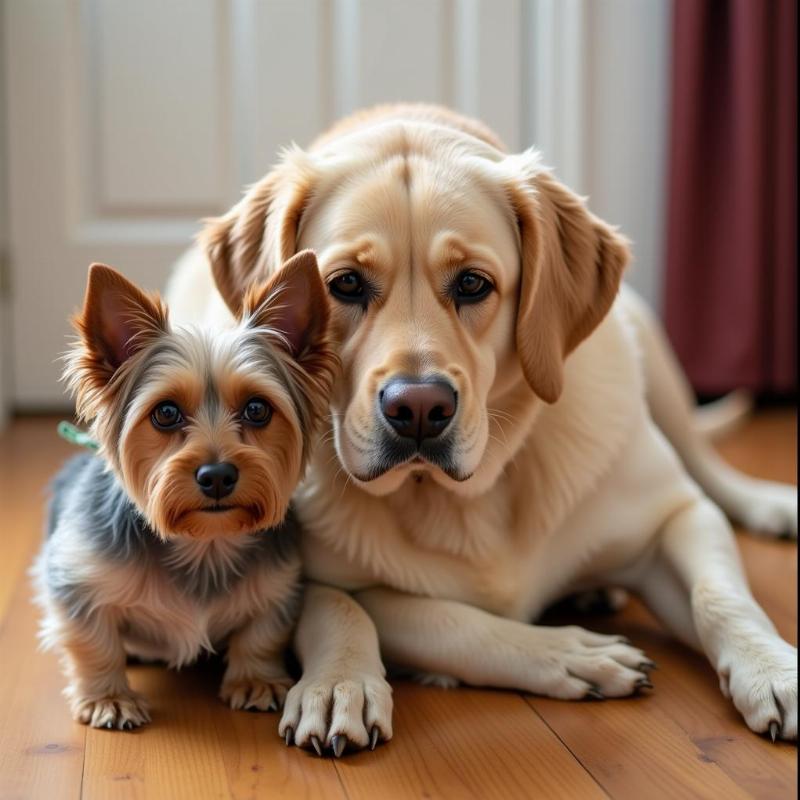Choosing the right combination of dogs, especially when considering size differences, is crucial for a harmonious household. Large dog and small dog dynamics can be incredibly rewarding, but also present unique challenges. Understanding these differences, and preparing for them, is key to a happy multi-dog home.
Understanding the Differences: Size Matters
When it comes to large dog and small dog interactions, size isn’t just about physical dimensions; it significantly impacts communication, play styles, and potential safety concerns. A playful nudge from a large dog can easily overwhelm a small dog, leading to fear or injury. While many large and small dogs coexist beautifully, proactive management is essential.
Communication Styles: Lost in Translation?
Large dogs and small dogs often communicate differently. A large dog’s deep bark can be intimidating to a smaller dog, while a small dog’s high-pitched yelp might be misinterpreted by a larger dog. Observe their body language closely. Are they relaxed and playful, or tense and anxious? Early identification of miscommunication can prevent misunderstandings escalating into conflict.
Safe and Engaging Play: Leveling the Playing Field
Playtime is vital for all dogs, but with large dog and small dog pairings, it needs careful supervision. Choose toys appropriate for each dog’s size and supervise their interactions. Avoid toys that could be easily swallowed by the smaller dog, and ensure the larger dog doesn’t become overly boisterous.
 Large and small dogs interacting safely
Large and small dogs interacting safely
Introducing a Large Dog and a Small Dog: Slow and Steady Wins the Race
Introducing a large dog and small dog requires patience and a controlled environment. Initial meetings should be brief, supervised, and on neutral territory. Use positive reinforcement, like treats and praise, to reward calm behavior. Gradual introductions build a foundation of trust and allow them to adjust to each other’s presence.
Feeding Time: Separate But Equal
Mealtimes can be a source of competition, especially with different sized dogs. Feed them in separate areas to prevent resource guarding. This ensures each dog feels safe and can eat at their own pace, minimizing stress and potential conflict.
Training for Success: Consistency is Key
Consistent training is paramount for both large and small dogs, especially in a multi-dog household. Basic obedience commands, like “sit,” “stay,” and “come,” provide structure and control. This helps prevent potential issues arising from size differences and establishes a clear hierarchy.
Expert Insights: Professional Advice for a Happy Home
“Integrating dogs of different sizes requires a mindful approach,” says Dr. Emily Carter, DVM. “Understanding their unique needs and communication styles is crucial for creating a safe and harmonious environment.” Dr. Carter further emphasizes the importance of consistent training and proactive management for a successful multi-dog household. “With patience and understanding, the rewards of having both a large and small dog can be immeasurable,” she adds.
Conclusion: Big and Small, Love Them All!
Living with a large dog and a small dog can be a wonderfully enriching experience. By understanding their differences, managing their interactions proactively, and providing consistent training, you can create a loving and safe environment for all members of your furry family. Remember, a little preparation goes a long way in fostering a harmonious home where both big and small can thrive together.
FAQ: Common Questions about Large and Small Dogs Living Together
- Can large dogs and small dogs live together peacefully? Absolutely! With proper introduction, training, and supervision, they can coexist beautifully.
- What are the biggest challenges of having a large and small dog? Differences in play styles, communication, and potential for accidental injury are key challenges.
- How can I ensure safe playtime between my large and small dog? Supervise their interactions, choose appropriate toys, and intervene if play becomes too rough.
- Should I feed my large and small dog together? It’s generally recommended to feed them separately to avoid competition and resource guarding.
- What type of training is essential for a multi-dog household? Basic obedience training is crucial for all dogs, especially in mixed-size homes.
- How can I tell if my large and small dog are getting along? Observe their body language for signs of relaxation, playfulness, and mutual respect.
- What should I do if my large dog seems to be intimidating my small dog? Consult a professional dog trainer or behaviorist for guidance on addressing the issue.
Beautdogs.us is your premier online destination for comprehensive and engaging information on dog care and companionship in the US. We offer expert advice on breeds, grooming, training, nutrition, and much more. Whether you’re a new dog owner or a seasoned enthusiast, Beautdogs.us is your trusted source for all things dog-related. Contact us today to learn more! Email: [email protected], Phone: +1 501-555-7529. Connect with us at Beautdogs.us.